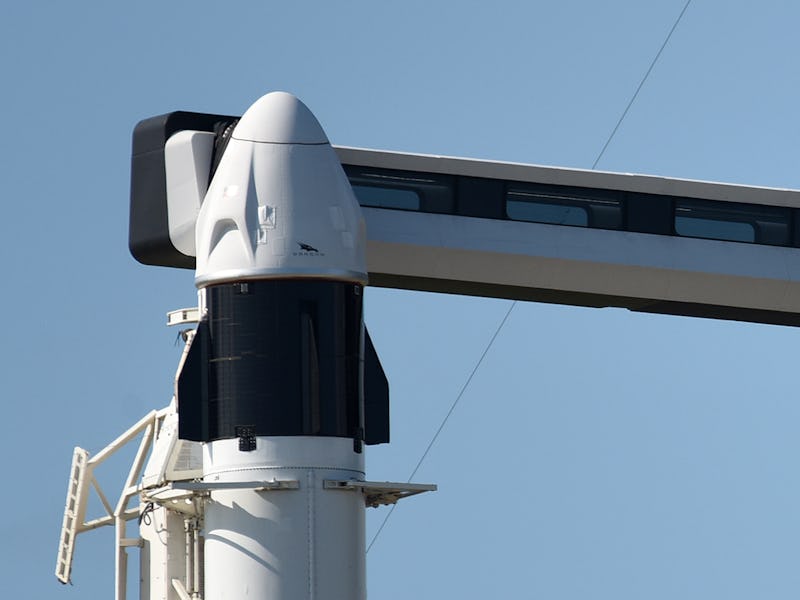SpaceX is investigating a key Crew Dragon component ahead of Crew-4 flight
SpaceX plans to launch Crew-4 in April.

SpaceX has stumbled across a surprising piece of information — and it could help it tweak how its astronauts return to Earth.
During a press briefing last week, as reported by SpaceNews, NASA and SpaceX revealed that one parachute on its Dragon capsules opened late in two consecutive missions. The capsule uses four parachutes to slow the capsule down as it returns to Earth. The data has pushed the team to act and resolve the discrepancy.
“So far we don’t see anything that looks strange in any of the imagery, or off-nominal,” Steve Stich, commercial crew program manager at NASA, said during the press event.
Resolving the issue will help one of SpaceX’s key components continue to push the company’s missions forward. SpaceX uses the Dragon capsule to send supplies to and from the International Space Station, while the Crew Dragon variant has enabled the company to send both astronauts and private citizens into space.
As SpaceX gears up for its next private crewed mission, Ax-1 in March, the company is getting ready to continue increasing access to space.
Want to find out more about SpaceX’s plans for Crew Dragon? Subscribe to MUSK READS+ for exclusive interviews and analysis about spaceflight, electric cars, and more.
SpaceX Crew Dragon: What did the team find?
SpaceX and NASA found that the fourth of the capsule’s four main parachutes opened slightly slower on two missions:
- On the Crew-2 mission, which launched on April 23, 2021. The parachute opened 75 seconds later than the other parachutes when it returned on November 8, 2021.
- On the 24th Commercial Resupply Services mission, which launched on December 21, 2021. The parachute opened 63 seconds later than the other three when it returned to Earth on January 24, 2022.
The team suggested that this issue could be caused by the other three parachutes shading the fourth, causing it to struggle to inflate. However, they also noted that the issue doesn’t seem to change how the capsule returns to Earth.
“If you look at the descent data, it looks just like a regular four-chute parachute return,” Bill Gerstenmaier, vice president of build and flight reliability at SpaceX, said at the conference. He added that the parachute still provides drag even when not fully inflated.
The plan now is to investigate why the issue occurred, seeing as there wasn’t any design changes that would have influenced the results on those two missions. Gersteinmaier said he expected the issue to be closed out ahead of the Axiom Space mission on March 30.
The team does not expect the issue to delay the Crew-4 mission, NASA’s next crewed mission to the International Space Station, scheduled for April 15.
SpaceX Crew Dragon: Why do we need parachutes?
SpaceX launches its Dragon capsule into space using the Falcon 9 rocket. While its rocket boosters increasingly return to Earth by re-firing their engines and landing on a drone ship, the capsule works a little differently. They instead use a series of parachutes to slow their descent as they land back on Earth.
In the case of the Dragon, the capsule uses two drogue parachutes to steady the capsule as it re-enters the atmosphere. It then uses its four main parachutes to slow the capsule down for its final return.
But parachutes are notoriously difficult to get right. As Musk noted in 2019, parachutes were one of the biggest issues during NASA’s Apollo program that sent humans to the Moon. The command module increased in size from 8,150 pounds in 1962 to 13,000 pounds in 1968.
Parachutes also caused SpaceX headaches during the Crew Dragon’s development. In 2019, the year before the first successful crewed flight, Gerstenmaier told a U.S. House committee hearing that reported parachute test failures were “part of the learning process.”
SUBSCRIBE TO MUSK READS+, A PREMIUM NEWSLETTER THAT COVERS THE WORLDS OF ELON MUSK, SPACEX, TESLA, AND EVERYTHING BETWEEN